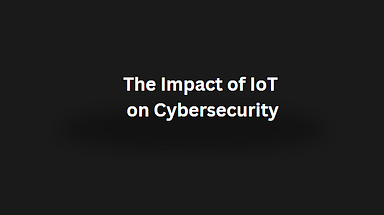In today’s digitally connected world, the Internet of Things (IoT) has become an essential component of our daily lives. From smart homes and wearable devices to industrial sensors and self-driving cars, IoT technology has transformed how we interact with the world around us. However, in addition to the numerous benefits that IoT provides, there are significant cybersecurity implications that must be addressed. In this blog post, we will look at the impact of IoT on cybersecurity and discuss strategies for mitigating the risks.
The Proliferation of Connected Devices
One of the most striking features of IoT is the sheer number of connected devices. According to estimates, there will be more than 35 billion IoT devices in use by 2021, with the number expected to grow exponentially in the coming years. While this interconnectedness provides unprecedented convenience and efficiency, it also opens up a large attack surface for cybercriminals to exploit.
Security Challenges in IoT
One of the most significant challenges in IoT security is the lack of consistent protocols and security measures across devices. Many IoT manufacturers prioritise functionality and cost-effectiveness over security, resulting in devices with vulnerabilities like default passwords, unencrypted communication channels, and insufficient software updates. These flaws can be used by malicious actors to gain unauthorised access to devices or launch cyberattacks.
Cybersecurity Threats in IoT
The interconnected nature of IoT devices introduces a variety of cybersecurity risks. One of the most concerning is the possibility that IoT devices will be compromised and used as part of a botnet. Botnets are networks of compromised devices controlled by a single entity, which are frequently used for malicious purposes such as Distributed Denial of Service (DDoS) attacks or malware distribution. The large number of IoT devices, combined with their often lax security measures, make them prime targets for botnet operators.
Data Privacy and Security
Another major concern in IoT cybersecurity is the privacy and security of data sent and stored by connected devices. IoT devices frequently collect large amounts of sensitive data about users, behaviours, and environments. If this information falls into the wrong hands, it could be used for identity theft, fraud, or other malicious activity. Ensuring the confidentiality, integrity, and availability of IoT data is critical for maintaining trust in IoT ecosystems.
Mitigating IoT Security Risks
Addressing the cybersecurity challenges presented by IoT necessitates a multifaceted approach. Manufacturers must prioritise security in the design and manufacturing of IoT devices, including strong authentication mechanisms, encryption protocols, and secure update mechanisms. Organisations and individuals must also take proactive steps to secure their IoT environments, such as regularly updating firmware, using strong passwords, and separating IoT networks from critical systems.
Conclusion
The Internet of Things has transformed how we interact with technology, but it also presents complex cybersecurity challenges that must be addressed. Understanding the risks associated with IoT and implementing appropriate security measures allows us to maximise the potential of IoT technology while protecting against cyber threats. Vigilance and proactive risk management are critical in today’s ever-changing IoT cybersecurity landscape to ensure a secure and resilient future.





Pingback: Malware, Spyware & Adware - NRS.help